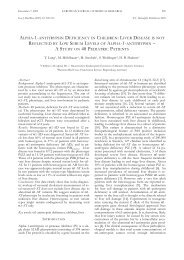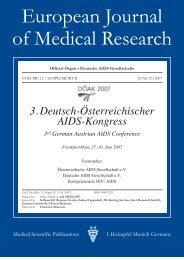EFFECT OF EXTRACELLULAR HYPERTONICITY AND ALKALOSIS ...
EFFECT OF EXTRACELLULAR HYPERTONICITY AND ALKALOSIS ...
EFFECT OF EXTRACELLULAR HYPERTONICITY AND ALKALOSIS ...
- No tags were found...
You also want an ePaper? Increase the reach of your titles
YUMPU automatically turns print PDFs into web optimized ePapers that Google loves.
72 EUROPEAN JOURNAL <strong>OF</strong> MEDICAL RESEARCHFebruary 27, 2004lateral damage to the vascular smooth musclecells. These problems make the interpretation ofthe results of such experiments difficult.Secondary effects can be excluded by studying theinteractions of modulators of blood flow regulationin vitro. We chose the EA.hy 926 cell line asan endothelial model system in vitro. This cellline was originally established in 1983 by Edgelland coworkers through the hybridization ofhuman umbilical vein endothelial cells with thehuman lung carcinoma cell line A 549 (Edgell etal. 1983). EA.hy926 cells are a well characterizedendothelial cell model system (Bauer et al. 1992;Emeis and Edgell 1988; Li et al. 2002). We studiedthe effects of the metabolic stimuli alkalosisand/or hyperosmolality on the release of endothelinand cGMP from EA.hy 926 cells into the cellculture medium.Since extracellular alkalosis induces a vasoconstrictionand hyperosmolarity a vasodilatation invivo, the hypothesis was tested in vitro that alkalosisis associated with the release of the vasoconstrictorysubstance endothelin and hyperosmolalitywith that of vasodilatory NO.METHODSCELL CULTUREEA.hy 926 cells were grown in Dulbecco´s HAT(hypoxanthine 13,6 mg/l, aminopterine 0,176mg/l, thymidine 3,88 mg/l) medium supplementedwith 10% fetal calf serum (FCS) and 10000IU/ml penicillin and 10000 μg/ml streptomycin.Confluent cell monolayers were passaged at a 1:5ratio. The cells were used up to passage 20 afterthawing from frozen stock (obtained from Dr.Edgell via Prof. Friedel, Darmstadt, Germany).MEASUREMENT <strong>OF</strong> CELL SIZEConfluent cell monolayers were trypsinized andthe cells were suspended in an electrolyte solution.The cell suspension was injected into a cellcounter (Casy® 1 Model DT, Schärfe SystemGmbH, Reutlingen, Germany). The cells werecounted photoelectrically and the cell counts andcell diameters were plotted.EXPERIMENTAL INCUBATIONSThree groups of confluent cell monolayers fromthe same cell passage were studied in parallel.A: control, EA.hy 926 that were grown in regulargrowth medium as described above.B: cell monolayers incubated with hyperosmolalmedia containing mannitol (50, 100, 200 mM)C: cell monolayers incubated with sodium bicarbonate(25, 50, 100 mM).pH <strong>AND</strong> OSMOLALITYThe pH of the incubation solutions was measuredby using a pH-meter (WTW Weilheim, Germany)and osmolality was measured using an Osmomat030 (ABBOTT GmbH, Wiesbaden, Germany).ENDOTHELIN <strong>AND</strong> cGMP MEASUREMENTSThe concentration of endothelin and cGMP wasmeasured in the cell culture supernatant, respectivelycell lysates using commercial ELISA-kits accordingto the manufacturers’ instructions (endothelin:Cayman Chemical Company, Ann Arbor,Michigan, USA; cGMP: Amersham PharmaciaBiotech, Freiburg, Germany). The concentrationmeasurements were carried out photometrically(Modell Spectra, SLT-Labinstruments GmbH,Grödig/Salzburg, Austria), the background ofcell-free incubation control medium was subtractedfrom the readings. Standard curves were establishedfor each experiment in the phenol-red containingincubation media by adding endothelin/cGMPin known-concentrations.VIABILITY TESTSThe activity of LDH was measured in the conditionedsupernatants using standard clinical chemistrytechniques (LDH reagent kit, Rolf GreinerGmbH, Frickenhausen, Germany). The cells werecounted photoelectrically using an automatic cellcounter (Casy® 1 Model DT, Schärfe SystemGmbH, Reutlingen, Germany). The diameter ofEA.hy 926 cells (11 - 26 μm) was determined inpilot experiments.CELL PROLIFERATION ASSAYThe proliferation of EA.hy 926 cells was assessedby measuring the incorporation of bromodeoxyuridine(BrdU) into the cells. The measurementswere carried out using the proliferation ELISA-kit(Roche, Mannheim, Germany) according to themanufacturer´s instructions. The incorporationof the pyrimidine-analogue BrdU instead of thymidinewas measured photometrically after incubationwith a peroxidase-coupled anti-BrdU-antibodyand a subsequent reaction with tetramethylbenzidine.STATISTICSThe results are shown as means ± standard errorof the mean (SEM). Comparative statistics werecarried out with Student’s t-test, P < 0.05 wasconsidered significant. The Bonferroni-Holm correctionwas used for multiple comparisons.RESULTSVIABILITY TESTSFigure 1 shows the distribution of cell size. Thecell size was normally distributed between 11 and26 μm; cells with a diameter between 11 and 26 μmwere counted in the experimental measurements.Table 1 shows the pH and osmolality of the ex-





